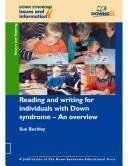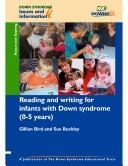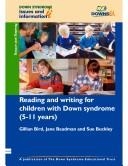Reading and Writing for Individuals with Down Syndrome: An Overview (Down Syndrome Issues & Information) (Pt. 1)

Buy online ($)
Type
Publication
Authors
ISBN 10
1903806097
ISBN 13
9781903806098
Category
Reference
[ Browse Items ]
Publication Year
2001
Publisher
Pages
32
Description
While the published information on the reading development and reading achievements of individuals with Down syndrome is still limited, many authors now recognise the benefits of teaching children with Down syndrome to read and of involving them in literacy activities. Reading progress and being involved in supported reading and writing influences speech, language and memory skills for all children, including those with Down syndrome. Children with Down syndrome educated in mainstream inclusive classrooms achieve higher levels of literacy than those of similar ability educated in special schools. Children with Down syndrome learn to read in the same way as typically developing children but they make use of their good visual memory skills to read and are slower to be able to use phonics. However, when they have reading skills in the 7 to 8 year level (based on norms for typically developing children), they begin to use their phonic skills independently to read and to spell, like other children. There are considerable individual differences in rates of literacy progress among children with Down syndrome, but if they have access to good teaching, their reading abilities are, on average, about two years behind their age in primary school, while language and number abilities are often more delayed, therefore reading ability is a strength for many of the children. Recent studies from Australia and the UK indicate that some 60% to 70% of individuals with Down syndrome can achieve functional levels of literacy by adult life. Children introduced to literacy as a language teaching activity in preschool years reach the highest levels of achievement, but individuals may make significant progress at any age into early adulthood, and many late starters do achieve functional levels of literacy. Reading should be taught and pupils involved in the daily use of literacy throughout teenage and adult years, particularly for those individuals who may not have made progress earlier. - from Amzon
Number of Copies
8
| Library | Accession No | Call No | Copy No | Edition | Location | Availability |
|---|---|---|---|---|---|---|
| Main | 78 | 1 | Yes | |||
| Main | 97 | 2 | Yes | |||
| Main | 130 | 3 | Yes | |||
| Main | 151 | 4 | Yes | |||
| Main | 166 | 5 | Yes | |||
| Main | 180 | 6 | Yes | |||
| Main | 197 | 7 | Yes | |||
| Main | 209 | 8 | Yes |




